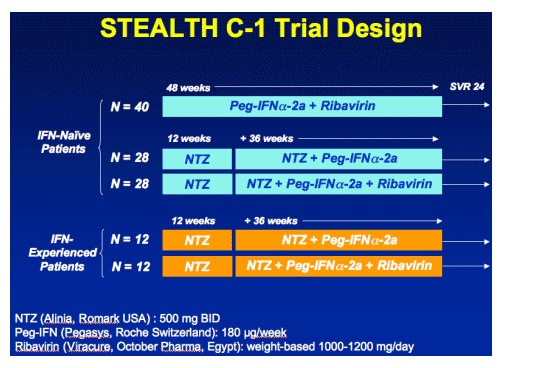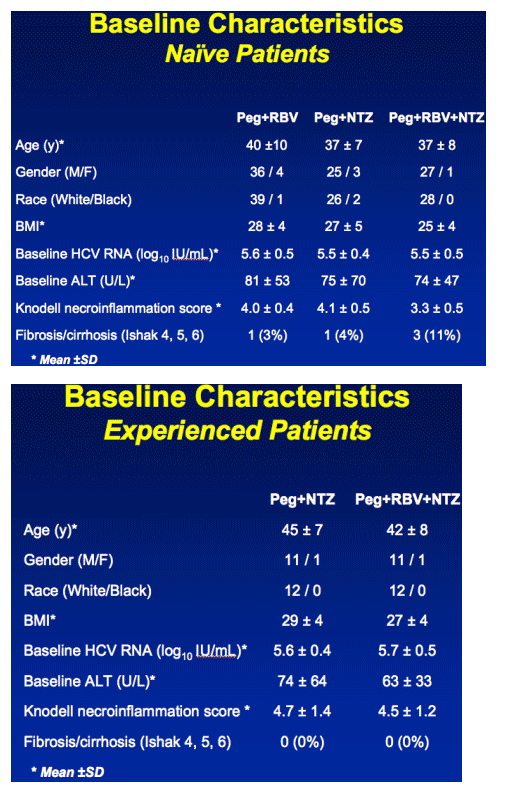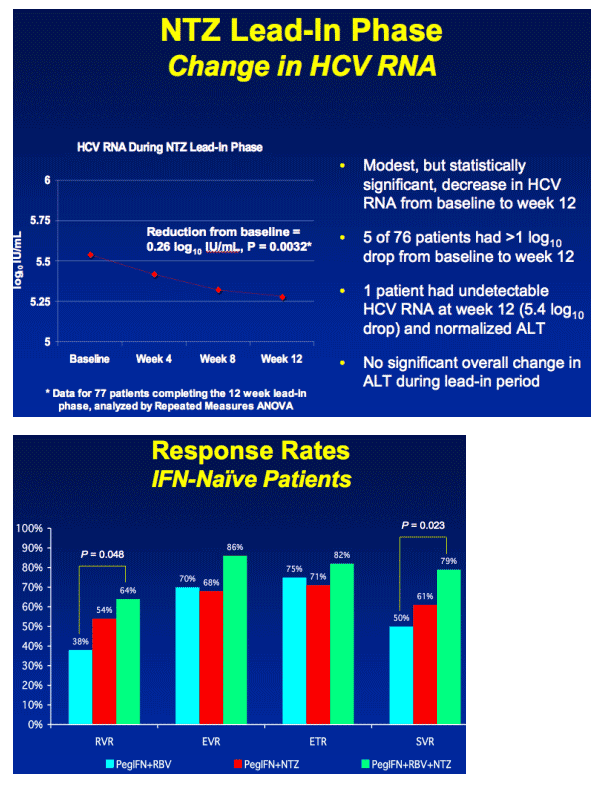 |
 |
 |
| |
Randomized Controlled Trial of Nitazoxanide-Peginterferon-Ribavirin, Nitazoxanide-Peginterferon and Peginterferon-Ribavirin in the Treatment of Patients with Chronic Hepatitis C Genotype 4
|
| |
| |
Reported by Jules Levin
43rd EASL, April 2008, Milan Ital
This was an oral presentation at EASL.
Jean-Francois Rossignol, M.D., Ph.D.,1,2 Asem Elfert, M.D.,3 Yehia El-Gohary, M.D.,4 Emmet B. Keeffe, M.D.1,2
1Romark Institute for Medical Research, Tampa, FL, 2Division of Gastroenterology and Hepatology, Department of Medicine, Stanford University School of Medicine, Stanford, CA, 3Department of Gastroenterology and Hepatology, University of Tanta, Faculty of Medicine, Tanta, Egypt, 4Department of Tropical Medicine and Infectious Diseases, University of Alexandria, Faculty of Medicine, Alexandria, Egypt
AUTHOR SUMMARY
Interferon-naive patients
Triple regimen of Peg-IFN+RBV+NTZ achieved higher SVR than standard of care (79% vs. 50%)
SVR with dual regimen of Peg-IFN+NTZ was not different from standard of care (61% vs. 50%)
No increase in side effects noted with use of NTZ
Results achieved with reduced duration of Peg-IFN therapy to 36 weeks
Interferon-experienced patients
SVR with PEG+RBV+NTZ was higher but not significantly different from PEG+NTZ (25% vs. 8%)
Nitazoxanide
Background
Broad spectrum of clinical activity against parasites, anaerobic bacteria and viruses
Initially developed for treatment of parasites, and licensed by FDA (Alinia) for treatment of Cryptosporidium and Giardia in 2002
Antiviral activity against HCV and HBV discovered by serendipity in patients with HIV/AIDS and Cryptosporidium infection who had HBV or HCV coinfection
First member of new class of small molecules, the thiazolides, that are cell signal modulators
Potent inhibitor of HCV in replicon systems1
Mechanism of action: enhances intracellular activity of interferon by inducing eIF2alfa phosphorylation2
Does not induce resistance via mutations in HCV replicon3
1Korba BE, et al. Antir. Res. 2008;77:56-63. 2Glenn JS. Unpublished data.
3Korba BE, et al. Antimicrob. Agents. Chemother. In press; EASL, 2008, abstract #22.
Phase II study of nitazoxanide monotherapy of chronic hepatitis C for 24 weeks demonstrated an ETR of 30% and SVR of 17%, with all virologic responders having low baseline HCV RNA (<385,000 IU/mL)1
Initial pilot study demonstrated the safety, antiviral activity, and increased virologic response rate of treatment with nitazoxanide combined with peginterferon
1Rossignol JF, et al. EASL, 2008, abstract #831.
Rationale for Lead-in Phase
Pilot studies (unpublished) showed greater efficacy if NTZ was administered before peginterferon plus ribavirin versus starting all three drugs at same time
Laboratory studies demonstrated that pretreatment of HCV replicon-containing cells with NTZ potentiated the antiviral effect of subsequent exposure to NTZ plus INF_1
1Korba BE, et al. Antir. Res. 2008;77:56-63
OBJECTIVE
The objective of this study was to determine the safety and antiviral efficacy of nitazoxanide in combination with peginterferon, with or without ribavirin, for the treatment of patients with chronic hepatitis C genotype 4
Study conducted as part of the Romark STEALTH C clinical development program (Studies to Evaluate Alinia for Treatment of Hepatitis C)

GENERAL INCLUSION CRITERIA
Naive and Experienced Patients
--Age ≥18 years
--Chronic hepatitis C ≥6 months based on detectable anti-HCV by EIA and serum HCV RNA
--HCV genotype 4
--Evidence of chronic hepatitis on liver biopsy
--Compensated liver disease
Experienced Patients
Prior clinical failure to peginterferon therapy (heterogeneous clinical definitions)
KEY EXCLUSION CRITERIA
Genotypes other than genotype 4
Decompensated liver function
Other causes of liver disease
History of alcoholism or alcohol use >40 g/day
Coinfection with HBV or HIV
Pregnancy or inadequate birth control
Hemoglobinopathies
Other conditions making it unlikely that a course of therapy could be completed
METHODS
Liver biopsy at baseline
Drug treatment:
- Nitazoxanide (Alinia, Romark, Tampa) : 500 mg BID with food
- Peg-IFN alfa-2a (Pegasys, Roche, Switzerland): 180 μg/week
- Ribavirin (Viracure, October Pharma, Egypt): standard weight-based dosing (1000 to 1200 mg/day)
Clinic visits every 4 weeks with physical examination and laboratory tests for safety and efficacy
Serum HCV RNA assessed by:
- Bayer Versant v. 3.0 (LOQ = 615 IU/mL)
- Abbott m2000 (LOQ = 10 IU/mL)
Patients undetectable only if HCV RNA < LOQ by both assays



Safety Analysis: Summary
Adverse Events (AEs)
Most common AEs were anemia, thrombocytopenia and neutropenia, characteristic of PEG + RBV
Two AEs were serious: fever Æ hospitalization (PEG+RBV), and MVA Æ death (PEG+NTZ)
Eight patients discontinued medications because of AEs (5 in Peg-IFN+RBV and 3 in Peg-IFN+NTZ arm)
Another 11 patients experienced dose reductions secondary to AEs
Proportion of AEs were similar in the treatment arms, except for more anemia in the ribavirin arms
|
| |
|
 |
 |
|
|